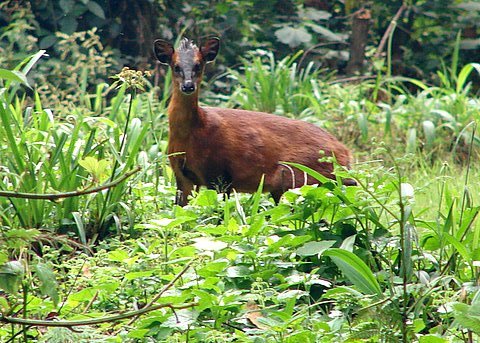 Forest duikers belong to the family
Bovidae, subfamily Cephalophinae and genus Cephalophus. This is the
largest and least known of the antelope genera. There are 18 forest
duiker species in Africa, 13 of which are found in Eastern Africa.
Forest duikers feed on a variety of foods like fruits, barks, seeds and
fungi. Duikers are known to be important seed dispersers, and seeds of
some tree species are exclusively dispersed by duikers such as
Ricinodendron africana. The population status of duikers in Mgahinga
Gorilla National Park (MGNP) had not yet been documented.
Forest duikers belong to the family
Bovidae, subfamily Cephalophinae and genus Cephalophus. This is the
largest and least known of the antelope genera. There are 18 forest
duiker species in Africa, 13 of which are found in Eastern Africa.
Forest duikers feed on a variety of foods like fruits, barks, seeds and
fungi. Duikers are known to be important seed dispersers, and seeds of
some tree species are exclusively dispersed by duikers such as
Ricinodendron africana. The population status of duikers in Mgahinga
Gorilla National Park (MGNP) had not yet been documented.
The study was carried out between March
and August 1998. The major aim was to provide baseline information on
duikers in MGNP including species availability, habitat preference,
population density and relative abundance, as well as identifying
suitable methods for a future ecological monitoring programme.
Four line transects ranging from 4 to
5.7km in length were set up, stratified by vegetation type. Transect 1
was set in the zone of previously encroached forest and transect 2 in a
relatively undisturbed forest area. Transect 3 ran from Mt Sabinyo to
Rugezi swamp, an area of heather forest, a herbaceous zone, mixed
bamboo, a swamp and pure bamboo forest. Transect 4 passed through mixed
bamboo, Hypericum and Erica woodland, Hagenia woodland and finally
through heather forest, from the slopes of Mt Gahinga to the Nyagisenyi
gorge on Mt. Muhabura. Direct and indirect counts were done within a
distance of 50m from the transect line. 30 park rangers and guides were
interviewed on their knowledge of occurrence of the duikers. Patrol
record books were also studied.
 Only one species of duikers was recorded-
the black fronted duiker (Cephalophus nigrifrons). Duikers were
found at almost all altitudes, but mainly between 2450 and 3500m and
preferred closed to open forest and grassland. Solitary animals were
seen more often than groups of two or three individuals. The population
density of the duikers was estimated to be 18/km2 throughout the park.
Duiker density was lowest close to the park boundaries. The
black-fronted duiker was not endangered in MGNP.
Only one species of duikers was recorded-
the black fronted duiker (Cephalophus nigrifrons). Duikers were
found at almost all altitudes, but mainly between 2450 and 3500m and
preferred closed to open forest and grassland. Solitary animals were
seen more often than groups of two or three individuals. The population
density of the duikers was estimated to be 18/km2 throughout the park.
Duiker density was lowest close to the park boundaries. The
black-fronted duiker was not endangered in MGNP.
The author concluded by suggesting that to
monitor duiker population more efficiently in MGNP, specialised rangers
had to be trained and joint patrols with adjacent parks carried out.


 Forest duikers belong to the family
Bovidae, subfamily Cephalophinae and genus Cephalophus. This is the
largest and least known of the antelope genera. There are 18 forest
duiker species in Africa, 13 of which are found in Eastern Africa.
Forest duikers feed on a variety of foods like fruits, barks, seeds and
fungi. Duikers are known to be important seed dispersers, and seeds of
some tree species are exclusively dispersed by duikers such as
Ricinodendron africana. The population status of duikers in Mgahinga
Gorilla National Park (MGNP) had not yet been documented.
Forest duikers belong to the family
Bovidae, subfamily Cephalophinae and genus Cephalophus. This is the
largest and least known of the antelope genera. There are 18 forest
duiker species in Africa, 13 of which are found in Eastern Africa.
Forest duikers feed on a variety of foods like fruits, barks, seeds and
fungi. Duikers are known to be important seed dispersers, and seeds of
some tree species are exclusively dispersed by duikers such as
Ricinodendron africana. The population status of duikers in Mgahinga
Gorilla National Park (MGNP) had not yet been documented.  Only one species of duikers was recorded-
the black fronted duiker (Cephalophus nigrifrons). Duikers were
found at almost all altitudes, but mainly between 2450 and 3500m and
preferred closed to open forest and grassland. Solitary animals were
seen more often than groups of two or three individuals. The population
density of the duikers was estimated to be 18/km2 throughout the park.
Duiker density was lowest close to the park boundaries. The
black-fronted duiker was not endangered in MGNP.
Only one species of duikers was recorded-
the black fronted duiker (Cephalophus nigrifrons). Duikers were
found at almost all altitudes, but mainly between 2450 and 3500m and
preferred closed to open forest and grassland. Solitary animals were
seen more often than groups of two or three individuals. The population
density of the duikers was estimated to be 18/km2 throughout the park.
Duiker density was lowest close to the park boundaries. The
black-fronted duiker was not endangered in MGNP.